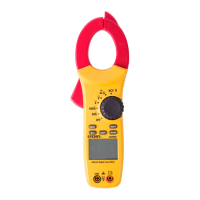5
3-2. General Specification
• The maximum voltage allowed between terminal and ground: 600 VDC or 600 VAC
• Altitude: Maximum 2000m
• Display: 5999 count
• Sampling time: ~ 2.5 times / sec
• Automatic power off: 15 Minutes (Unless disabled)
• Battery type: (3) 1.5V AAA
• Temperature coefficient: <.1 x (specified accuracy) / °C
• Operating temperature: 0°C ~ 40°C
• Storage temperature: -20°C ~ 60°C
• Approximate size: 10.5” x 3.5” x 2”
• Weight: ~460.85 grams (Including batteries, excluding leads)
• Crush test: 250 lbs
• Drop test: 10 ft
• Max open size of jaw diameter: 28mm
• Safety: IEC61010-1;IEC61010-2-032; CATIV 600V
3-3. Accessories
• 1 red & 1 black 1000V, 10A test lead
• 3 AAA batteries
• Carrying case
4. PREPARATION FOR MEASUREMENT
4-1. Check the condition of the meter
Do not use a meter with visible signs of damage. Examine the meter housing before you use the product. Look for cracks,
missing plastic or exposed metal. Carefully examine the insulation around the Common and Input terminals.
4-2. Check the battery voltage
Start with the dial in the “OFF” position then rotate the dial to any position. Confirm that the low battery symbol is not displayed on the
LCD screen. If the low battery symbol
is displayed follow the instructions in Section 7, Battery Replacement. (It is important to start
from the “Off” position to ensure that a blank screen is not due to the auto off feature.)
4-3. Check the battery cover
The battery cover must be in place and securely fastened before powering on the meter or connecting test leads to a circuit.
See Section 7, Battery Replacement.
4-4. Check test lead condition, continuity and rating
Do not use damaged test leads. Examine the test leads for worn or cracked insulation. Check test lead continuity.
Do not use test leads in applications that exceed their CAT rating. Check the CAT rating of the test leads.
4-5. Checking the switch setting & operation
Confirm the dial is set to the correct position for the measurement function being performed. Confirm that the symbols displayed
on the LED screen match the measurement function. (Refer to Figure 2). Ensure that the Data Hold feature is disabled.
5. MEASUREMENT
5-1. Resistance/Continuity/Diode
RESISTANCE MEASUREMENT Ω
1. Insert test leads – Insert the black test lead into the COM input and the red test lead into the
input.
2. Set Ω function – Turn the dial to the
function.
3. Select Function – There are a total of 3 functions that are accessible by pressing the SELECT key.
The Resistance function is the default option. Press the SELECT key until Ω appears on the display.
4. Short the tips of the test leads – Short the tips of the test leads together and confirm the LCD screen shows near zero.
5. Test & Measure – Place the red and black test leads at both the positive and negative points to be measured. The clamp meter will
automatically select the proper range and the display will show the resistance value of the measurement being taken on the display.
When the test leads are not connected or the resistance value is too great, the display will show an over-range symbol “OL”.
WARNING
When measuring resistance, the circuit should be powered off and all capacitors should be completely discharged prior to testing.
A more accurate measurement can be achieved by separating the component from the circuit being tested.

